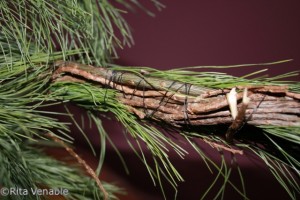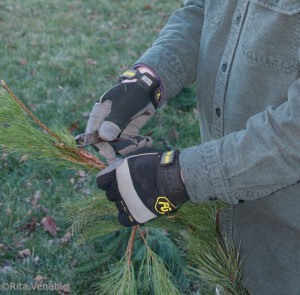The feel and smell of natural pine garlands at Christmas are delightful. Once upon a time, my husband and I lived on a five-acre mini-farm in Franklin, TN. Our neighbors, who were a football field away, always put a pine garland around their front door at Christmastime each year. Front porch lights, switched on each night, were adorned with more greenery and big red bows. A white board fence in front of the house completed the picture of country charm.
Was it nostalgia for these simpler times that caused my husband and me to buy a real pine garland this year or was it the super deal we found at a Boy Scout stand near our home? Although the attendant told us that the wire might be a problem later on, we dismissed this advice and bought about 50 feet of garland. After all, our extended family was coming over Christmas Day and we wanted the house to look festive. Dean Martin singing “Rudolf (Rudy), the Red-nosed Reindeer” and Bing singing “White Christmas” somehow nudged us over the Christmas cliff.
We strung up pine garland everywhere—over the fireplace, over the dining room cabinet, on the front foyer table, and, of course, over the front door. Surely we would have won the “Best Rendition of a Traditional Christmas” award if our suburban neighborhood had such an award.
After a week or so, however, indoor pine needles started falling off. Since we have a dog with a sensitive stomach, we got out the vacuum cleaner pronto. Family pets eat the needles, and the American Veterinary Medical Association states that pine needles can be dangerous for pets to ingest.
Later, Christmas and New Year’s celebrations were over, and it was time to remove the decorations. How do we dispose of the pine garland? I called our county recycling agency and the person who answered the phone told me that I would have to contact the recycle and dump attendant.
The county recycle and dump attendant said the wire could not go through their shredder, so I called the city solid waste department. The clerk told me that they could not accept the wired pine garland either. The succinct reply was, “The machines cannot deal with it.”
So, I reasoned to myself, What if we took all of the wire from the garland and separated it out for recycling?
We started doing this and timed ourselves. We took the garlands outside so the needles wouldn’t fall on the floor. It took us 4 minutes per foot to unravel wire and plastic twine from the garland, separate them, and put the branches in the brown brush bag. (Still don’t know where to recycle the wire and the plastic twine.) At this rate, it would take 1 hour and 40 minutes to unravel 25 feet of pine garland and 3 hours and 20 minutes to separate the whole 50 feet.
We ended up putting everything in the regular trash which will go to the landfill. The pine will eventually disintegrate, but the wire will take years probably.
Still, if you compare that to artificial garlands which are made of plastic, which is better environmentally? The people who make artificial pine garlands will say that theirs is the most environmentally-friendly way because no trees are cut down to produce the garlands. The people who produce natural pine garlands will probably say their product is best because it doesn’t use plastics (except for the twine).
Next year? I think I will just gather cedar branches from our yard and place them around. They may not surround the front door, but they will look good on the mantle. Afterwards, I can remove them and put them in the mulched area of the yard to decompose or put them in the brown brush bags for pick up.
It will save transportation costs and we’ll have more time to listen to Dean and Bing, drink boiled custard with flavorin’, and think about our old neighbors. We might even win the “Martha Stewart Best Use of Yard Materials” award for our neighborhood.



